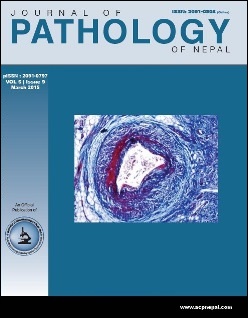Retinoblastoma: An institutional experience
DOI:
https://doi.org/10.3126/jpn.v5i9.13780Keywords:
Histopathology, IRSWG, retinoblastoma, choroidAbstract
Background: This article aims to describe histopathologic high risk tumor characteristics in our patient population of retinoblastoma. It is based on consensus criteria for definitions of choroidal and optic nerve invasion as outlined in The International RetinoblastomaStaging Working Group (IRSWG) 2009.
Materials and Methods: Fifty histopathologically diagnosed cases of retinoblastoma were archived from records of Pathology department during years 2004 to 2014. Re-evaluation of slides to identify choroidal and optic nerve invasion as per IRSWG along with Pathologic tumor staging was done. Data were entered into Microsoft excel sheets and results expressed in percentages. Department of Ophthalmology was consulted for recurrence of Retinoblastoma.
Results: Among fifty cases, Choroidal invasion was absent in 62% cases. Minimal invasion (<3mm) was seen in 18% cases, massive (>3mm) in 14% cases and extra ocular involvement in 6% cases. The optic nerve was free of tumor in more than three forth of the cases (78%). Prelaminar and retro laminar involvement of optic nerve was observed in 6% and 10% cases respectively. Intraocular spread of tumor was observed in 6% of cases. The cut margin of optic nerve was involved in 42% while it was free of tumor in 58% of cases. Significant number of tumours were pathologically classified as pT1 (58%) followed by pT2a (22%). pT3a and pT4b were found in 6% each and pT3b and pT4a were found in 4% each. Recurrence was observed in two cases of PT3a and one of pT4b.
Conclusion: We conclude identifying low percentages of high risk charateristics in a retrospective histologic experience with Retinoblastoma. Recurrence observed in two tumours staged pT3a sheds light on prognostic significance of reporting massive choroidal invasion despite free cut margin. These observations call for routine practice of standardized histopathologic reporting and processing of enucleated eye samples at our tertiary care centre.
Journal of Pathology of Nepal (2015) Vol. 5, 723-726
Downloads
Downloads
Published
How to Cite
Issue
Section
License
This license enables reusers to distribute, remix, adapt, and build upon the material in any medium or format, so long as attribution is given to the creator. The license allows for commercial use.




